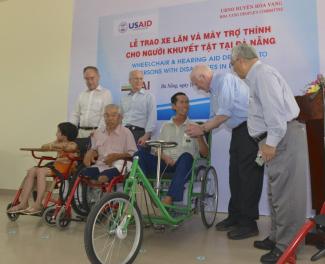Vietnam and USAID began working together in 1991, when USAID launched programs benefiting Vietnamese with disabilities through the Patrick Leahy War Victims Fund, established in 1989. People with disabilities throughout Vietnam received rehabilitative services, prosthetics and orthopedic support devices, and improved care through training of doctors and other health workers. In the early 1990s, program activities in Vietnam were ‑ for the most part‑ limited to assistance to war victims, orphans and disaster relief.
Since the official normalization of the U.S.‑Vietnam relationship in 1995, USAID's assistance has grown steadily, changing significantly in terms of funding levels, complexity, and the scope of its programs.
Currently, USAID manages comprehensive portfolios in economic growth and governance, higher education, health (including HIV, TB and other pandemic threats and disease), environment and climate change, biodiversity/countering wildlife trafficking, support to persons with disabilities and other vulnerable populations and disaster assistance. USAID has played a key role in helping Vietnam reach out to global markets through its accession to the World Trade Organization and the Vietnam - U.S. Bilateral Trade Agreement. In partnership with the Government of Vietnam, USAID continues to promote greater market integration by supporting Vietnam’s implementation of free trade agreements. We have also committed to a joint project with the Government of Vietnam to remove contaminated soil from Bien Hoa Airbase, the largest remaining dioxin hot spot in Vietnam after the completion of the Environmental Remediation of Dioxin Contamination at Danang Airport in 2018.
USAID Key Milestones
- 1991: USAID began disabilities programming through Patrick Leahy War Victims Fund.
- November 19, 2000: In the presence of U.S. President William J. Clinton, Assistant Administrator for the Asia and the Near East (ANE) Bureau Robert C. Randolph opens the Office of the United States Agency for International Development (USAID) in Hanoi.
- 2001: USAID launches the Support for Trade Acceleration (STAR) project to support Vietnam for BTA implementation.
- 2004: Vietnam becomes 15th PEPFAR (U.S. President’s Emergency Plan for AIDS Relief) Focus Country.
- 2005: Agreement for Economic and Technical Cooperation signed.
- 2007: USAID/Vietnam Representative Office established.
- 2010: USAID/Vietnam reaches full Mission status.
- 2013: Presidents of the United States and Vietnam agree to a “Comprehensive Partnership” identifying a number of key priority areas supported by USAID: Trade and Economic Ties, Science and Technology Cooperation, Education Cooperation, Environment and Health, and War Legacy Issues.
- 2013: USAID/Vietnam’s Country Development Cooperation Strategy for 2014-2018 is approved.
- 2016: During former President Barack Obama’s historic visit to Vietnam, both countries highlight that development cooperation continues to be a driving force in the bilateral relationship and pledge to advance inclusive economic growth, climate mitigation and adaptation; combat wildlife trafficking; and clean up dioxin contamination.
- May 2017: Vietnamese Prime Minister Nguyen Xuan Phuc meets with President Donald Trump in Washington, D.C., further affirming the strength of the U.S.-Vietnam bilateral partnership in global health security; HIV/AIDS relief and prevention; dioxin; climate change; protection of human rights, including the disabled; and trade. Read their May 31, 2017 joint statement here.
- November 2017: At the invitation of President of the Socialist Republic of Vietnam Tran Dai Quang, President Donald Trump paid a state visit to Hanoi, Vietnam, from November 11 to12, 2017. The two leaders discussed measures to strengthen and expand the Comprehensive Partnership between their two countries based on mutual understanding, shared interests, and a common desire to promote peace, cooperation, prosperity, and security in the Indo-Pacific region. Read their November 12, 2017 joint statement here.
- November 2018: Remediation of dioxin-contaminated soil at Danang airport is successfully completed, following a six-year, $110 million effort between USAID and the Vietnamese Ministry of National Defense.
- December 2019: USAID and the Vietnamese Ministry of National Defense officially commence dioxin remediation ground operations at Bien Hoa airbase and surrounding area. This 10-year effort is expected to cost approximately $390 million, and is significantly more complex than the Danang remediation effort.
- December 2019: USAID and the Vietnamese Ministry of National Defense sign a Memorandum of Intent to implement a $65 million, five-year program to support persons with disabilities.
- May 2020: USAID/Vietnam’s Country Development Cooperation Strategy for 2020-2025 is approved.
- August 2021: During her first official visit to Vietnam, Vice President Kamala Harris announced U.S. government funding provided through USAID to help Vietnam continue to fight COVID-19, as well as new initiatives to increase clean energy and natural resource conservation efforts, boost Vietnam’s inclusive business environment, strengthen higher education, and continue improving the lives of people with disabilities.
- On May 13, 2022, USAID Administrator Samantha Power met with Prime Minister of the Socialist Republic of Vietnam Pham Minh Chinh to discuss strengthening development cooperation and USAID’s ongoing efforts to combat the climate crisis and environmental pollution, improve higher education, and address war legacies in Vietnam.
- March 7-10, 2023: USAID Administrator Samantha Power visited Vietnam to strengthen a partnership marked by years of expanded engagement and cooperation, built on a foundation of jointly addressing the legacies of war. She met with students, persons with disabilities, farmers, businesses, local organizations, and government officials to discuss the U.S. and Vietnam’s partnership on shared priorities, including addressing climate change, deepening engagement in the Mekong Delta, investing in higher education, and spurring continued inclusive economic growth.

USAID/Vietnam
